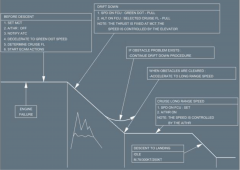![]()
![]()
![]()
Use LEFT and RIGHT arrow keys to navigate between flashcards;
Use UP and DOWN arrow keys to flip the card;
H to show hint;
A reads text to speech;
7 Cards in this Set
- Front
- Back
|
Crew Incapacitation |
If a cockpit crew member becomes incapacitated, the remaining crewmember must call a flight attendant as soon as practicable. FLIGHT ATTENDANT .............................CONTACT - Call the flight attendants via the CALLS pb or PA. - The lead flight attendant or any other flight attendant must proceed to the cockpit immediately. The flight attendant must then: - Tighten and manually lock the shoulder harness of theincapacitated crew member. - Push the seat completely aft. - Recline the seat back. It takes 2 people to remove the dead weight of an unconscious body froma seat without endangering any controls and switches. If it is not possibleto remove the body, one flight attendant must remain in the cockpit to takecare of and observe the incapacitated crew member. In coordination with the flight attendant: - Request assistance from any medically qualified passenger. - Check if a type qualified company pilot is on board to replace theincapacitated crew member. |
|
|
One Engine Inoperative(Obstacle Strategy) |

|
|
|
Severe Turbulence |
SIGNS...............................................ON AUTOPILOT.....................................KEEP ON A/THR (when thrust changes become excessive)..........DISCONNECT TURBULENCE SPEED................................. SET - Reference “Speed and Thrust Setting for Recommended Turbulence Speed” tables below. DESCENT..................................... CONSIDER - Consider descending to or below OPT FL in order to increase buffet margin. FOR APPROACH: A/THR in managed speed............................USE *****************************************Speed and Thrust Setting for Recommended Turbulence Speed If severe to extreme turbulence is unavoidable, aim to keep the speed inthe region of the target speed given in the following tables, so as to providethe best protection against the effects of gust on structural limits whilemaintaining an adequate margin above VLS. Note: Speed Charts in last two pages of COM V2 |
|
|
Stall Recovery |
Note: As soon as any stall indication (could be aural warning, buffet...) is recognized, apply the immediate actions: NOSE DOWN PITCH CONTROL . . . . . . .APPLY - This will reduce angle of attack. Note: In case of lack of pitch down authority, reducing thrust may be necessary. BANK...................................... WINGS LEVEL When out of stall (no stall indication): THRUST............INCREASE SMOOTHLY AS NEEDED Note: In case of one engine inoperative, progressively compensate the thrust asymmetry with rudder. SPEED BRAKES......................CHECK RETRACTED FLIGHT PATH......................RECOVER SMOOTHLY If in clean configuration and below 20,000 ft: FLAP1..................................... SELECT Note: If a risk of ground contact exists, once clearly out of stall (no stall indication), smoothly establish a positive climbgradient. |
|
|
Stall Warning at Lift-Off |
Note: Spurious stall warning may sound in NORMAL law, if an angle of attack probe is damaged. In this case, immediately and simultaneously, apply the following actions: THRUST...........................................TOGA PITCH ATTITUDE......................................15° BANK.......................................WINGS LEVEL Note: When a safe flight path and speed are achieved and maintained,if stall warning continues, consider it as spurious. |
|
|
Windshear |
A red flag "WINDSHEAR" is displayed on each PFD associated with an aural synthetic voice "WINDSHEAR" repeated three times. If windshear is detected either by the system or by pilot observation, apply the following recovery technique: - At Takeoff: - If before V1: The takeoff should be rejected only if significant airspeed variations occur below indicated V1 and the pilot decides that there is sufficient runway remaining to stop the airplane. If after V1: THR LEVERS..................................TOGA REACHING VR ...............................ROTATE SRS ORDERS .............................. FOLLOW - If necessary the Flight Crew may pull the sidestick fully back. Note: - Autopilot disengages if the angle of attack value goes above α prot. - If the FD bars are not displayed, move toward an initial pitch attitude of 17.5°. Then, if necessary, to prevent a loss in altitude, increase the pitch attitude. Airborne, initial climb or landing: THR LEVERS AT TOGA.............SET OR CONFIRM AP (if engaged)................................ KEEP ON SRS ORDERS .................................FOLLOW - If necessary the Flight Crew may pull the sidestick fully back. Note: - Autopilot disengages if the angle of attack value goes above α prot. - If the FD bars are not displayed, move toward an initial pitch attitude of 17.5°. Then, if necessary, to prevent a loss in altitude, increase the pitch attitude. Do not change configuration (slats/flaps, gear) until out of shear. Closely monitor flight path and speed. Recover smoothly to normal climb out of shear. Note: Refer to FOM - “Weather” chapter for further windshear information. |
|
|
Windshear Ahead (predictive windshear alert triggered) |
The "W/S AHEAD" message is displayed on each PFD. The color of the message depends on the severity and location of the windshear. Note: When a predictive windshear alert ("WINDSHEAR AHEAD" or"GO AROUND WINDSHEAR AHEAD") is triggered, if the FlightCrew makes a positive verification that no hazard exists, then the alert may be disregarded, as long as: - There are no other signs of possible windshear conditions, and - The reactive windshear system is operational. Known cases of spurious predictive windshear alerts have been reported at some airports, during either takeoff or landing, due tothe specific obstacle environment. However, always rely on any reactive windshear ("WINDSHEAR"). |

